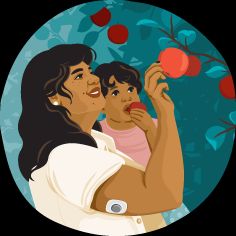Symptoms, age of onset, and outlook depend on a person’s type of muscular dystrophy. Read on for more about this group of conditions and how they may affect you.
Muscular dystrophies affect people of all sexes. However, the two most common types, Duchenne and Becker, are much more common in males assigned at birth (MAAB).
Combined, muscular dystrophies
Muscular dystrophy is a group of conditions that damage and weaken your muscles over time.
This damage and weakness are due to the lack of a protein called dystrophin, which is necessary for typical muscle function. A deficiency of this protein can cause problems with walking, swallowing, and muscle coordination, among other symptoms.
Most diagnoses occur in childhood, although they can occur at any age. The outlook for muscular dystrophy depends on the type of muscular dystrophy and the severity of symptoms.
There are several types of muscular dystrophy, which vary in symptoms and severity. They include:
1. Duchenne muscular dystrophy (DMD)
Duchenne muscular dystrophy (DMD) is the most common among children. Most individuals affected are children assigned male at birth. It’s rare for children assigned female at birth to develop it.
Studies estimate the incidence of DMD to be about
Symptoms tend to begin between ages 2 and 6 years. They include:
- trouble walking
- loss of reflexes
- difficulty standing up
- poor posture
- bone thinning
- scoliosis, an abnormal curvature of the spine
- learning differences
- breathing difficulties
- swallowing problems
- lung and heart weakness
Most people with DMD start using a wheelchair before their teenage years.
In the past, people lived with DMD into their late teens or 20s. However, it’s now more common for people to live into their 30s. This is due in part to advances in medical treatment, including cardiac and respiratory care.
2. Becker muscular dystrophy (BMD)
Both Becker muscular dystrophy (BMD) and DMD are caused by a problem in skeletal muscle producing dystrophin. Dystrophin is completely absent in DMD, whereas people with BMD have some, but it’s not enough for normal functioning.
As a result, BMD is similar in symptoms to DMD but less severe. Muscle weakness occurs mostly in the arms and legs, with symptoms appearing
Other BMD symptoms include:
- walking on the toes
- frequent falls
- muscle cramps
- trouble getting up from the floor
This type of muscular dystrophy is also more common in children assigned male at birth. Many with this condition won’t choose to use a wheelchair until they’re in their mid-30s or older, and a small percentage of people never require one. Most people with BMD live until middle age or later.
In the United States, BMD occurs in about
3. Congenital muscular dystrophy (CMD)
Congenital muscular dystrophy (CMD) is often apparent between birth and 2 years old. This is when parents begin noticing that their child’s motor functions and muscle control aren’t developing as they should.
Symptoms vary and may include:
Symptoms range from mild to severe. The lifespan of someone with this type of muscular dystrophy also varies, depending on their symptoms. Some people with CMD pass away in infancy, while others
4. Myotonic dystrophy (DM)
This form of muscular dystrophy causes myotonia, which is an inability to relax your muscles after they contract. Myotonic dystrophy is also called Steinert’s disease.
People with other types of muscular dystrophy don’t experience myotonia, but it’s a symptom of other muscle diseases.
Myotonic dystrophy can affect your:
- facial muscles
- central nervous system (CNS)
- adrenal glands
- heart
- thyroid
- eyes
- gastrointestinal tract
Symptoms most often appear first in the face and neck. They include:
- drooping muscles in the face, producing a thin, drawn look
- difficulty lifting the neck due to weak neck muscles
- difficulty swallowing
- droopy eyelids, or ptosis
- early baldness in the front area of the scalp
- poor vision, including cataracts
- weight loss
- increased sweating
This dystrophy type may also cause impotence and testicular atrophy. In others, it may cause irregular periods and infertility.
DM diagnoses are most likely to occur
5. Facioscapulohumeral muscular dystrophy (FSHD)
Facioscapulohumeral muscular dystrophy (FSHD) affects the muscles in the face, shoulders, and upper arms. This type of muscular dystrophy is also known as Landouzy-Dejerine disease.
FSHD may cause:
- difficulty chewing or swallowing
- slanted shoulders
- a crooked appearance of the mouth
- a wing-like appearance of the shoulder blades
A smaller number of people with FSHD may develop hearing and respiratory problems.
FSHD tends to progress slowly. Symptoms usually appear
6. Limb-girdle muscular dystrophy (LGMD)
Limb-girdle muscular dystrophy (LGMD) refers to a group of more than 20 inherited conditions. They cause muscle weakening and a loss of muscle bulk. The symptoms usually begin in the shoulders and hips but may also occur in the legs and neck.
You may find it hard to get up out of a chair, use stairs, and carry heavy items if you have LGMD. You may also stumble and fall more easily.
Overall,
Many people with this form of muscular dystrophy experience severe disability
7. Oculopharyngeal muscular dystrophy (OPMD)
Oculopharyngeal muscular dystrophy (OPMD) causes weakness in your facial, neck, and shoulder muscles. Other symptoms include:
- drooping eyelids
- vision problems
- trouble swallowing
- voice changes
- heart problems
- difficulty walking
OPMD is one of the rarer types of muscular dystrophy, affecting
8. Distal muscular dystrophy
Distal muscular dystrophy is also called distal myopathy. It’s a group of over six diseases affecting the muscles furthest from the shoulders and hips, specifically the:
- forearms
- hands
- calves
- feet
The condition may also affect your respiratory system and heart muscles. The symptoms tend to progress slowly and include a loss of fine motor skills and difficulty walking.
Most people develop symptoms of distal muscular dystrophy
This condition is also particularly rare, affecting
9. Emery-Dreifuss muscular dystrophy (EDMD)
Emery-Dreifuss muscular dystrophy (EDMD) usually begins in childhood and tends to affect more children assigned male at birth than children assigned female at birth. The symptoms include:
- weakness in the upper arm and lower leg muscles
- breathing problems
- heart problems
- shortening of the muscles in the spine, neck, ankles, knees, and elbows
Differences in genes cause muscular dystrophy.
Thousands of genes are responsible for the proteins that determine muscle integrity. People carry genes on 23 pairs of chromosomes, with one-half of each pair inherited from a biological parent.
One of these pairs of chromosomes is sex-linked. This means the traits or conditions you inherit as a result of those genes may depend on your sex or the sex of your parent. The other 22 pairs are not sex-linked and are also known as autosomal chromosomes.
A change in one gene can lead to deficiencies in dystrophin, a critical protein. The body may not make enough dystrophin, may not make it the right way, or may not make it at all.
People develop muscular dystrophy in one of four ways. The gene differences that cause muscular dystrophy are normally inherited, but they can also come from a spontaneous mutation.
Autosomal dominant inherited disorder
A person inherits a gene difference from just one parent, on one of the 22 autosomal chromosomes.
Each child has a
Autosomal recessive inherited disorder
A person inherits a gene difference from both parents, on one of the 22 autosomal chromosomes. The parents are carriers of the gene but don’t develop muscular dystrophy themselves.
Children have a
Sex-linked (X-linked) disorder
This inheritance is connected to the genes linked to the X chromosome.
Parents may carry two X chromosomes or an X and a Y chromosome.
A child with a faulty X chromosome develops muscular dystrophy if they also inherit a Y chromosome (as is typically the case with children assigned male at birth).
They’re only carriers if they inherit an X chromosome from the other parent (as with children assigned female at birth). This other X chromosome offsets the effect of the X chromosome with the gene difference, as it can produce dystrophin.
Spontaneous mutation
In this case, muscular dystrophy develops because of a spontaneous change in genes. It
Once the change occurs, the carrier can pass it on to their children.
Muscular dystrophy progresses a bit differently for every person. Complications also vary depending on the type of muscular dystrophy. Some of the more common complications affect:
- movement
- breathing
- the heart
- the spine
Mobility changes
Progressive muscle weakness can eventually limit mobility. Many people with muscular dystrophy will eventually use assistive technology and devices, such as a wheelchair. Specially designed wheelchairs can improve comfort, possibly reduce pain, and provide adequate muscle support.
Respiratory issues
Muscular dystrophy can cause breathing problems, as muscle weakness makes breathing harder. Trouble swallowing can lead to aspiration, or having substances in the airway or lungs. Overall, it’s harder for the respiratory system to do its job of bringing oxygen into the body and exhaling carbon dioxide.
Cardiac issues
The lack of dystrophin can also affect the heart since it’s a muscle.
People with muscular dystrophy often have cardiomyopathy or heart muscle disease. As part of ongoing muscular dystrophy treatment, doctors assess your heart health and may recommend heart medication.
Contractures and scoliosis
Muscular dystrophy can also affect the skeletal muscles, which allow for flexibility in the tendons and joints. The result is a pulling of tendons and joints into a flexed position, which can become permanent. This is called a contracture.
Weakness in the spinal muscles can cause scoliosis, a curvature of the spine.
Some contractures may be relieved with surgery. Corticosteroids and physical therapy may help prevent the onset of scoliosis.
Pregnancy considerations
People with muscular dystrophy who become pregnant
For example, muscle weakness in the legs, hips, and abdominal muscles may make it hard to push during labor, increasing the chance of cesarean delivery or other interventions.
The generalized muscle weakness that can come with myotonic dystrophy can lead to pregnancy loss. Pregnancy can also lead to people with myotonic dystrophy experiencing a faster onset of their condition and a worsening of their symptoms.
A number of tests can help your doctor diagnose muscular dystrophy. Your doctor can perform:
- Blood testing: High levels of serum creatine kinase, serum aldolase, and myoglobin may all signal the need for further testing to confirm or rule out muscular dystrophy.
- Genetic testing: High levels of creatine kinase and signs of insufficient dystrophin may indicate a need for genetic testing. This type of testing looks for a large mutation of the dystrophin (DMD) gene. If there’s no large mutation, the next set of genetic tests will look for small mutations.
- Electromyography (EMG): EMG measures the muscle’s electrical activity using an electrode needle that enters your muscle. It can help doctors distinguish muscular dystrophy from a nerve disorder.
- Neurological physical exam: This exam rules out nervous system disorders and identifies the state of muscle strength and reflexes.
- Cardiac testing: Cardiac testing identifies heart problems that sometimes occur with muscular dystrophy. Tests include an echocardiogram to look at the structure of the heart.
- Imaging tests: MRI and ultrasound help doctors see the amount of muscle inside the body.
- Exercise assessments: Exercise assessments look at muscle strength, breathing, and how exercise affects the body.
There’s currently no cure for muscular dystrophy, but treatments can help manage your symptoms and slow disease progression.
Treatments depend on your symptoms and the kind of muscular dystrophy you have. For example, since many different mutations can cause BMD and DMD, some emerging treatments that might work for DMD, might
Medications
The Food and Drug Administration (FDA) has approved new treatments for some people with DMD. Many of these treatments use a new process called “exon skipping,” where the faulty segment (exon) of the dystrophin gene is patched over so the body can produce the protein.
These new treatments include:
- Eteplirsen (Exondys 51): This weekly injection is for people with a specific mutation of the dystrophin gene that is amenable to exon 51 skipping. According to the FDA’s 2016 approval notice, this applies to
about 13% of people with DMD. - Golodirsen (Vyondys 53): This weekly injection is for people with a dystrophin gene difference amenable to exon 53 skipping. This applies to
about 8% of people with DMD, according to the FDA’s 2019 approval notice. - Viltolarsen (Viltepso): This is also a weekly injection for those with a dystrophin gene difference that’s amenable to exon 53 skipping. The FDA approved viltolarsen (Viltepso) in 2020.
- Casimersen (Amondys 45): This weekly injection is for those with a gene difference amenable to exon 45 skipping. This applies to
about 8% of people with DMD, according to the FDA’s 2021 approval notice. - Deflazacort (Emflaza): This is a corticosteroid available in tablet and oral suspension forms. It’s approved for people ages 5 years and older with DMD.
Gene therapy
In 2023, the
Other research is ongoing in the space of gene therapy for treating muscular dystrophy.
Muscle therapy
Forms of muscle therapy have proven to be effective. These techniques involve working with a professional to improve physical function. Types of therapy include:
- physical therapy, including physical activity and stretching, to keep muscles strong and flexible
- respiratory therapy, to prevent or delay breathing problems
- speech therapy, to conserve muscle strength through specific techniques such as slower speech, pausing between breaths, and using special equipment
Occupational therapy, a process that focuses on daily activities, can help those with muscular dystrophy:
- become more independent
- gain access to community services
- improve coping skills
- improve social skills
Other treatments
Other treatment options include:
- corticosteroid drugs to help strengthen muscles and slow muscle deterioration
- assisted ventilation if respiratory muscles are affected
- medication for cardiac problems
- surgery to treat cardiac problems
- surgery to help correct the shortening of muscles
- surgery to repair cataracts
- surgery to treat scoliosis
What can trigger muscular dystrophy?
Muscular dystrophies are genetic conditions. A family history of muscular dystrophy is a risk factor for being a carrier or developing muscular dystrophy.
Because DMD and BMD are linked to the X chromosomes, children assigned male are much more likely to experience them.
However, even though children assigned female receive an X chromosome from each parent and should have adequate dystrophin production, they can still experience symptoms of DMD or BMD, such as muscle cramps, weakness, and heart issues.
What is the life expectancy of muscular dystrophy?
The life expectancy of a person living with muscular dystrophy depends on the type. For example, people with BMD tend to live for about
Can you fully recover from muscular dystrophy?
There’s currently no known cure for any of the muscular dystrophies, but treatments and therapies are available.
What is the earliest age of muscular dystrophy?
Congenital muscular dystrophy typically develops from birth.
A person’s type of muscular dystrophy largely determines their symptoms, age of onset, and outlook.
Breakthrough research and medications have the potential to slow the progression of DMD symptoms and offer more advanced medical options for many people with muscular dystrophy and their families.




